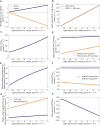Metabolic Modeling of the C3-CAM Continuum Revealed the Establishment of a Starch/Sugar-Malate Cycle in CAM Evolution
- PMID: 33584741
- PMCID: PMC7874232
- DOI: 10.3389/fpls.2020.573197
Metabolic Modeling of the C3-CAM Continuum Revealed the Establishment of a Starch/Sugar-Malate Cycle in CAM Evolution
Abstract
The evolution of Crassulacean acid metabolism (CAM) is thought to be along a C3-CAM continuum including multiple variations of CAM such as CAM cycling and CAM idling. Here, we applied large-scale constraint-based modeling to investigate the metabolism and energetics of plants operating in C3, CAM, CAM cycling, and CAM idling. Our modeling results suggested that CAM cycling and CAM idling could be potential evolutionary intermediates in CAM evolution by establishing a starch/sugar-malate cycle. Our model analysis showed that by varying CO2 exchange during the light period, as a proxy of stomatal conductance, there exists a C3-CAM continuum with gradual metabolic changes, supporting the notion that evolution of CAM from C3 could occur solely through incremental changes in metabolic fluxes. Along the C3-CAM continuum, our model predicted changes in metabolic fluxes not only through the starch/sugar-malate cycle that is involved in CAM photosynthetic CO2 fixation but also other metabolic processes including the mitochondrial electron transport chain and the tricarboxylate acid cycle at night. These predictions could guide engineering efforts in introducing CAM into C3 crops for improved water use efficiency.
Keywords: CAM cycling; CAM evolution; CAM idling; crassulacean acid metabolism; flux balance analysis; metabolic modeling.
Copyright © 2021 Tay, Odang and Cheung.
Conflict of interest statement
The authors declare that the research was conducted in the absence of any commercial or financial relationships that could be construed as a potential conflict of interest.
Figures



Similar articles
-
CAM Models: Lessons and Implications for CAM Evolution.Front Plant Sci. 2022 Jun 23;13:893095. doi: 10.3389/fpls.2022.893095. eCollection 2022. Front Plant Sci. 2022. PMID: 35812979 Free PMC article. Review.
-
CAM photosynthesis: the acid test.New Phytol. 2022 Jan;233(2):599-609. doi: 10.1111/nph.17790. Epub 2021 Nov 5. New Phytol. 2022. PMID: 34637529 Free PMC article.
-
Engineering of Crassulacean Acid Metabolism.Annu Rev Plant Biol. 2021 Jun 17;72:77-103. doi: 10.1146/annurev-arplant-071720-104814. Epub 2021 Apr 13. Annu Rev Plant Biol. 2021. PMID: 33848427
-
A Synthetic Facultative CAM-Like Shuttle in C3 Rice Plants.Adv Sci (Weinh). 2025 Apr;12(13):e2500418. doi: 10.1002/advs.202500418. Epub 2025 Feb 7. Adv Sci (Weinh). 2025. PMID: 39921297 Free PMC article.
-
Achievable productivities of certain CAM plants: basis for high values compared with C3 and C4 plants.New Phytol. 1991 Oct;119(2):183-205. doi: 10.1111/j.1469-8137.1991.tb01022.x. New Phytol. 1991. PMID: 33874131 Review.
Cited by
-
CAM Models: Lessons and Implications for CAM Evolution.Front Plant Sci. 2022 Jun 23;13:893095. doi: 10.3389/fpls.2022.893095. eCollection 2022. Front Plant Sci. 2022. PMID: 35812979 Free PMC article. Review.
-
CAM photosynthesis: the acid test.New Phytol. 2022 Jan;233(2):599-609. doi: 10.1111/nph.17790. Epub 2021 Nov 5. New Phytol. 2022. PMID: 34637529 Free PMC article.
-
Shifts in evolutionary lability underlie independent gains and losses of root-nodule symbiosis in a single clade of plants.Nat Commun. 2024 May 27;15(1):4262. doi: 10.1038/s41467-024-48036-3. Nat Commun. 2024. PMID: 38802387 Free PMC article.
-
CAM evolution is associated with gene family expansion in an explosive bromeliad radiation.Plant Cell. 2024 Oct 3;36(10):4109-4131. doi: 10.1093/plcell/koae130. Plant Cell. 2024. PMID: 38686825 Free PMC article.
-
A Guide to Metabolic Network Modeling for Plant Biology.Plants (Basel). 2025 Feb 6;14(3):484. doi: 10.3390/plants14030484. Plants (Basel). 2025. PMID: 39943046 Free PMC article. Review.
References
-
- Cheung C. Y. M., Poolman M. G., Fell D. A., Ratcliffe R. G., Sweetlove L. J. (2014). A Diel Flux Balance Model Captures Interactions between Light and Dark Metabolism during Day-Night Cycles in C3 and Crassulacean Acid Metabolism Leaves. Plant Physiol. 165 917–929. 10.1104/pp.113.234468 - DOI - PMC - PubMed
LinkOut - more resources
Full Text Sources
Other Literature Sources
Miscellaneous

